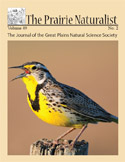Great Plains Natural Science Society

The Prairie Naturalist
Date of this Version
6-2010
Document Type
Article
Citation
The Prairie Naturalist· 42( 112): June 2010, pp 61-64
Abstract
The little blue heron (Egretta caerulea) is native to North America and most commonly breeds along the coast of the southeastern United States and the Gulf of Mexico through Central America and into South America (Rodgers and Smith 1995). In North America, little blue herons rarely nest outside their coastal range. However, nesting has been documented at several locations in the northern plains including Brown, Kingsbury, and Charles Mix counties, South Dakota (Naugle et al. 1996, Tallman et al. 2002); Pope County, Minnesota (Green and Janssen 1975); and possibly in southeastern Saskatchewan (Nero and Lein 1971, Smith et al. 1996). In North Dakota, there have been several spring and summer observations of little blue herons, but nesting has been confirmed only once (Jones and Malcolm 1978, Lokemoen 1979). In 1976, Jones and Malcolm (1978) observed the first breeding record (6 nests) for little blue herons in North Dakota at 1. Clark Salyer National Wildlife Refuge in McHenry County. Here, we report successful nesting attempts of little blue herons, and a probable hybrid pairing of a little blue heron and a cattle egret, at a multi-species breeding colony at Chase Lake National Wildlife Refuge (Stutsman County) in central North Dakota. We also describe the water conditions under which the heron and egret rookery became established at the refuge.
Included in
Biodiversity Commons, Botany Commons, Ecology and Evolutionary Biology Commons, Natural Resources and Conservation Commons, Systems Biology Commons, Weed Science Commons
